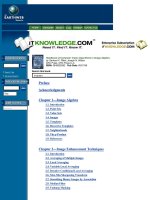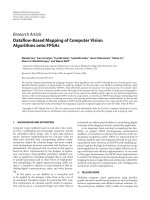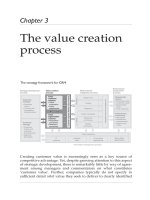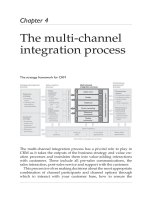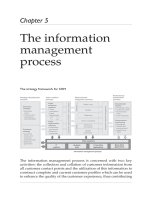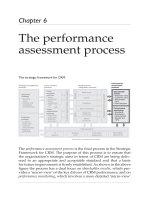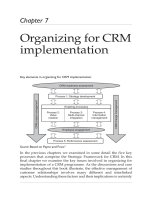ROBOTICS Handbook of Computer Vision Algorithms in Image Algebra Part 3 ppsx
Bạn đang xem bản rút gọn của tài liệu. Xem và tải ngay bản đầy đủ của tài liệu tại đây (1.39 MB, 20 trang )
Replacing by changes into
b = a •t,
the linear image-template product, where
, and .
Every template
has a transpose which is defined . Obviously, (s2)
2 = s and s2 reverses the mapping order from
to . By definition, and
, whenever and . Hence the binary operations and ³ induce
another product operation
where
is defined by
The expression is called the left product of a with s.
Previous Table of Contents Next
Products | Contact Us | About Us | Privacy | Ad Info | Home
Use of this site is subject to certain Terms & Conditions, Copyright © 1996-2000 EarthWeb Inc. All rights
reserved. Reproduction whole or in part in any form or medium without express written permission of
EarthWeb is prohibited. Read EarthWeb's privacy statement.
Replacing by changes into
b = a •t,
the linear image-template product, where
, and .
Every template
has a transpose which is defined . Obviously, (s2)
2 = s and s2 reverses the mapping order from
to . By definition, and
, whenever and . Hence the binary operations and ³ induce
another product operation
where
is defined by
The expression is called the left product of a with s.
Previous Table of Contents Next
Products | Contact Us | About Us | Privacy | Ad Info | Home
Use of this site is subject to certain Terms & Conditions, Copyright © 1996-2000 EarthWeb Inc. All rights
reserved. Reproduction whole or in part in any form or medium without express written permission of
EarthWeb is prohibited. Read EarthWeb's privacy statement.
It follows that the computation of the new pixel value b(y) does not depend on the size of X, but on the size of
S(t
y
). Therefore, if k = card(X ) S(t
y
)), then the computation of b(y) requires a total of 2k
2
- 1 operations of
type ³ and
.
As pointed out earlier, substitution of different value sets and specific binary operations for ³ and
results in
a wide variety of different image transforms. Our prime examples are the ring
and the value sets
and . The structure provides for two
lattice products:
where
and
where
In order to distinguish between these two types of lattice transforms, we call the operator the additive
maximum and
the additive minimum. It follows from our earlier discussion that if
, then the value of b(y) is -, the zero of under the operation of ¦. Similarly,
if
, then b(y) = .
The left additive max and min operations are defined by
and
respectively. The relationship between the additive max and min is given in terms of lattice duality by
where the image a* is defined by a*(x) = [a(x)]*, and the conjugate (or dual) of is the template
defined by . It follows that .
The value set
also provides for two lattice products. Specifically, we have
where
and
where
Here 0 is the zero of under the operation of ¦, so that b(y) = 0 whenever . Similarly,
b(y) = whenever
.
The lattice products
and are called the multiplicative maximum and multiplicative minimum,
respectively. The left multiplicative max and left multiplicative min are defined as
and
respectively. The duality relation between the multiplicative max and min is given by
where a*(x) = (a(x))* and . Here r* denotes the conjugate of r in .
Summary of Image-Template Products
In the following list of pertinent image-template products and . Again, for each operation
we assume the appropriate value set
.
right generic product
right linear product
right additive max
right additive min
right multiplicative max
right multiplicative min
right xor max
right xor min
In the next set of operations, .
left generic product
left linear product
left additive max
left additive min
left multiplicative max
left multiplicative min
Binary and Unary Template Operations
Since templates are images, all unary and binary image operations discussed earlier apply to templates as
well. Any binary ³ on
induces a binary operation (again denoted by ³) on as follows: for each pair
the induced operation s³t is defined in terms of the induced binary image operation on ,
namely (s³t)
y
a s
y
³t
y
y Y. Thus, if , and ³ = +, then (s + t)
y
= s
y
+ t
y
, where s
y
+
t
y
denotes the pointwise sum of the two images and .
The unary template operations of prime importance are the global reduce operations. Suppose Y is a finite
point set, say Y = {y
1
, y
2
, …, y
n
}, and . Any binary semigroup operation ³ on induces a global
reduce operation
which is defined by
Thus, for example, if and ³ is the operation of addition (³ = +), then “ = £ and
Therefore, is an image, namely the sum of a finite number of images.
In all, the value set
provides for four basic global reduce operations, namely
.
If the value set
has two binary operations ³ and so that is a ring (or semiring), then under
the induced operations
is also a ring (or semiring). Analogous to the image-template product, the
binary operations
and ³ induce a template convolution product
defined as follows. Suppose , and X a finite point set. Then the template product
, where , is defined as
Thus, if and , then r = s •t is given by the formula
Previous Table of Contents Next
Products | Contact Us | About Us | Privacy | Ad Info | Home
Use of this site is subject to certain Terms & Conditions, Copyright © 1996-2000 EarthWeb Inc. All rights
reserved. Reproduction whole or in part in any form or medium without express written permission of
EarthWeb is prohibited. Read EarthWeb's privacy statement.
The template t is not an -valued template. To provide an example of the template product , we
redefine t as
Then is given by
The utility of template products stems from the fact that in semirings the equation
holds [1]. This equation can be utilized in order to reduce the computational burden associated with typical
convolution problems. For example, if
is defined by , then
where
The construction of the new image b := a•r requires nine multiplications and eight additions per pixel (if we
ignore boundary pixels). In contrast, the computation of the image b := (a•s) •t requires only six
multiplications and four additions per pixel. For large images (e.g., size 1024 × 1024) this amounts to
significant savings in computation.
Summary of Unary and Binary Template Operations
In the following and denotes the appropriate value set.
generic binary operation
s³t : (s³t)
y
a s
y
³t
y
template sum
s + t : (s + t)
y
a s
y
+ t
y
max of two templates
s ¦ t : (s ¦ t)
y
a s
y
¦ t
y
min of two templates
s ¥ t : (s ¥ t)
y
a s
y
¥ t
y
generic reduce operation
sum reduce
product reduce
max reduce
min reduce
In the next list, , X is a finite point set, and denotes the appropriate value set.
generic template product
linear template product
additive max product
additive min product
multiplicative max product
multiplicative min product
1.6. Recursive Templates
In this section we introduce the notions of recursive templates and recursive template operations, which are
direct extensions of the notions of templates and the corresponding template operations discussed in the
preceding section.
A recursive template is defined in terms of a regular template from some point set X to another point set Y
with some partial order imposed on Y.
Definition. A partially ordered set
(or poset) is a set P together with a binary relation
, satisfying the following three axioms for arbitrary x, y, z P:
(i)
(reflexive)
(ii)
(antisymmetric)
(iii) (transitive)
Now suppose that X is a point set, Y is a partially ordered point set with partial order
, and a monoid. An
-valued recursive template t from Y to X is a function , where
and , such that
1.
and
2. for each
.
Thus, for each
is an -valued image on X and is an -valued image on Y.
In most applications, the relation X 4 Y or X = Y usually holds. Also, for consistency of notation and for
notational convenience, we define and so that . The
support of t at a point y is defined as
. The set of all -valued recursive
templates from Y to X will be denoted by
.
In analogy to our previous definition of translation invariant templates, if X is closed under the operation +,
then a recursive template
is called translation invariant if for each triple x, y, z X,
we have t
y
(x) = t
y+z
(x + z), or equivalently, and .
An example of an invariant recursive template is shown in Figure 1.6.1.
Figure 1.6.1 An example of an integer-valued invariant recursive template from .
If t is an invariant recursive template and has only one pixel defined on the target point of its nonrecursive
support
, then t is called a simplified recursive template. Pictorially, a simplified recursive template
can be drawn the same way as a nonrecursive template since the recursive part and the nonrecursive part do
not overlap. In particular, the recursive template shown in Figure 1.6.1 can be redrawn as illustrated in Figure
1.6.2
Figure 1.6.2 An example of an integer-valued simplified recursive template.
The notions of transpose and dual of a recursive template are defined in terms of those for nonrecursive
templates. In particular, the transpose t2 of a recursive template t is defined as
. Similarly,
, then the additive dual of t is defined by . The multiplicative dual for
recursive
-valued templates is defined in a likewise fashion.
Previous Table of Contents Next
Products | Contact Us | About Us | Privacy | Ad Info | Home
Use of this site is subject to certain Terms & Conditions, Copyright © 1996-2000 EarthWeb Inc. All rights
reserved. Reproduction whole or in part in any form or medium without express written permission of
EarthWeb is prohibited. Read EarthWeb's privacy statement.
Hence, recursive template operations are natural extensions of nonrecursive template operations.
Recursive additive maximum and multiplicative minimum are defined in a similar fashion. Specifically, if
and , then
is defined by
For and ,
is defined by
The operations of the recursive additive minimum and multiplicative minimum ( and ) are defined
in the same straightforward fashion.
Recursive additive maximum, minimum as well as recursive multiplicative maximum and minimum are
nonlinear operations. However, the recursive linear product remains a linear operation.
The basic recursive template operations described above can be easily generalized to the generic recursive
image-template product by simple substitution of the specific operations, such as multiplication and addition,
by the generic operations
and ³. More precisely, given a semiring with identity, then one can
define the generic recursive product
by defining by
Again, in addition to the basic recursive template operations discussed earlier, a wide variety of recursive
template operations can be derived from the generalized recursive rule by substituting different binary
operations for
and ³. Additionally, parameterized recursive templates are defined in the same manner as
parametrized nonrecursive templates; namely as functions
where P denotes the set of parameters, and with and
.
Summary of Recursive Template Operations
In the following list of pertinent recursive image-template products and . As
before, for each operation we assume the appropriate value set
.
recursive generic product
recursive linear product
recursive additive max
recursive additive min
recursive multiplicative max
right multiplicative min
The definition of the left recursive product is also straightforward. However, for sake of brevity and
since the different left products are not required for the remainder of this text, we dispense with their
formulation. Additional facts about recursive products, their properties and applications can be found in [1,
56, 57].
1.7. Neighborhoods
There are several types of template operations that are more easily implemented in terms of neighborhood
operations. Typically, neighborhood operations replace template operations whenever the values in the
support of a template consist only of the unit elements of the value set associated with the template. A
template
with the property that for each y Y, the values in the support of t
y
consist only of the
unit of
is called a unit template.
For example, the invariant template
shown in Figure 1.7.1 is a unit template with respect to the
value set
since the value 1 is the unit with respect to multiplication.
Figure 1.7.1 The unit Moore template for the value set .
Similarly, the template
shown in Figure 1.7.2 is a unit template with respect to the value set
since the value 0 is the unit with respect to the operation +.
Figure 1.7.2 The unit von Neumann template for the value set .
If
is an m × n array of points, , and is the 3 × 3 unit Moore template, then
the values of the m × n image b obtained from the statement b := a •t are computed by using the equation
We need to point out that the difference between the mathematical equality b = a •t and the pseudocode
statement b := a •t is that in the latter the new image is computed only for those points y for which
. Observe that since a(x) · 1 = a(x) and M(y) = S(t
y
), where M(y) denotes the Moore
neighborhood of y (see Figure 1.2.2), it follows that
This observation leads to the notion of neighborhood reduction. In implementation, neighborhood reduction
avoids unnecessary multiplication by the unit element and, as we shall shortly demonstrate, neighborhood
reduction also avoids some standard boundary problems associated with image-template products.
To precisely define the notion of neighborhood reduction we need a more general notion of the reduce
operation
, which was defined in terms of a binary operation ³ on . The more general
form of “ is a function
where .
Previous Table of Contents Next
Products | Contact Us | About Us | Privacy | Ad Info | Home
Use of this site is subject to certain Terms & Conditions, Copyright © 1996-2000 EarthWeb Inc. All rights
reserved. Reproduction whole or in part in any form or medium without express written permission of
EarthWeb is prohibited. Read EarthWeb's privacy statement.
, then the image-neighborhood product is defined by
for each y Y. Note that the product is similar to the image template product in that is a function
In particular, if is the Moore neighborhood, and is the 3 × 3
unit Moore template defined earlier, then a 1t = a 1M.
Likewise,
, where denotes the von Neumann unit template (Figure
1.7.2) and N denotes the von Neumann neighborhood (1.2.2). The latter equality stems from the fact that if
and , then since r
y
(x) = 0 for all x X ) S
-
(r
y
) and S
-
(r
y
) = N(y) for all
points
, we have that
Unit templates act like characteristic functions in that they do not weigh a pixel, but simply note which pixels
are in their support and which are not. When employed in the image-template operations of their semiring,
they only serve to collect a number of values that need to be reduced by the gamma operation. For this reason,
unit templates are also referred to as characteristic templates. Now suppose that we wish to describe a
translation invariant unit template with a specific support such as the 3 × 3 support of the Moore template t
shown in Figure 1.7.1. Suppose further that we would like this template to be used with a variety of reduction
operations, for instance, summation and maximum. In fact, we cannot describe such an operand without
regard of the image-template operation
by which it will be used. For us to derive the expected results, the
template must map all points in its support to the unitary value with respect to the combining operation
.
Thus, for the reduce operation of summation
, the unit values in the support must be 1, while for the
maximum reduce operation
, the values in the support must all be 0. Therefore, we cannot define a single
template operand to characterize a neighborhood for reduction without regard to the image-template operation
to be used to reduce the values within the neighborhood. However, we can capture exactly the information of
interest in unit templates with the simple notion of neighborhood function. Thus, for example, the Moore
neighborhood M can be used to add the values in every 3 × 3 neighborhood as well as to find the maximum or
minimum in such a neighborhood by using the statements a • M,
, and , respectively. This is one
advantage for replacing unit templates with neighborhoods.
Another advantage of using neighborhoods instead of templates can be seen by considering the simple
example of image smoothing by local averaging. Suppose
, where is an m × n array of
points, and
is the 3 × 3 unit Moore template with unit values 1. The image b obtained from the
statement
represents the image obtained from a by local averaging since the new pixel
value b(y) is given by
Of course, there will be a boundary effect. In particular, if X {(i,j) : 1 d i d m, 1 d j d n}, then
which is not the average of four points. One may either ignore this boundary effect (the most common
choice), or one may one of several schemes to prevent it [1]. However, each of these schemes adds to the
computational burden. A simpler and more elegant way is to use the Moore neighborhood function M
combined with the averaging reduction a a average. The simple statement
provides for the
desired locally averaged image without boundary effect.
Neighborhood composition plays an important role in algorithm optimization and simplification of algebraic
expressions. Given two neighborhood functions
, then the dilation of N
1
by N
2
,
denoted by N
1
• N
2
, is a neighborhood function which is defined as
where N(y) + q a {x + q : x N(y)}. Just as for template composition, algorithm optimization can be achieved
by use of the equation
for appropriate neighborhood functions and
neighborhood reduction functions “. For , the kth iterate of a neighborhood is
defined inductively as N
k
= N
k-1
•N, where .
Most neighborhood functions used in image processing are translation invariant subsets of
(in particular,
subsets of
). A neighborhood function is said to be translation invariant if
N(y + p) = N(y) + p for every point . Given a translation invariant neighborhood N, we define its
reflection or conjugate N* by N*(y) = N*(0) + y, where N*(0) = {-x : x N(0)} and
denotes
the origin. Conjugate neighborhoods play an important role in morphological image processing.
Note also that for a translation invariant neighborhood N, the kth iterate of N can be expressed in terms of the
sum of sets
N
k
(y) = N
k-1
(y) + N(0)
Furthermore, since
and , we have the symmetric relation
.
Previous Table of Contents Next
Products | Contact Us | About Us | Privacy | Ad Info | Home
Use of this site is subject to certain Terms & Conditions, Copyright © 1996-2000 EarthWeb Inc. All rights
reserved. Reproduction whole or in part in any form or medium without express written permission of
EarthWeb is prohibited. Read EarthWeb's privacy statement.
operations, it should be clear that these are defined in the usual way by simple substitution of the appropriate
neighborhood function for the corresponding Boolean template. For example, a parameterized neighborhood
with parameters in the set P is a function
. Thus, for each parameter p P, N(p) is a
neighborhood system for X in Z since N(p) : X ’ 2
Z
. Similarly, a recursive neighborhood system for a partially
ordered set
is a function satisfying the conditions that for each
x X,
, and for each .
1.8. The p-Product
It is well known that in the linear domain template convolution products and image-template products are
equivalent to matrix products and vector-matrix products, respectively [58, 1]. The notion of a generalized
matrix product was developed in order to provide a general matrix theory approach to image-template
products and template convolution products in both the linear and non-linear domains. This generalized
matrix or p-product was first defined in Ritter [59]. This new matrix operation includes the matrix and vector
products of linear algebra, the matrix product of minimax algebra [60], as well as generalized convolutions as
special cases [59]. It provides for a transformation that combines the same or different types of values (or
objects) into values of a possibly different type from those initially used in the combining operation. It has
been shown that the p-product can be applied to express various image processing transforms in computing
form [61, 62, 63]. In this document, however, we consider only products between matrices having the same
type of values. In the subsequent discussion,
and the set of all m × n matrices with entries
from
will be denoted by . We will follow the usual convention of setting and
view
as the set of all n-dimensional row vectors with entries from . Similarly, the set of all
m-dimensional column vectors with entries from is given by .
Let m, n, and p be positive integers with p dividing both m and n. Define the following correspondences:
and
Since r
p
(i,k) < r
p
(i2,k2) Ô i < i2 or i = i2 and k < k2, r
p
linearizes the array using the row
scanning order as shown:
It follows that the row-scanning order on is given by
or, equivalently, by
We define the one-to-one correspondence
The one-to-one correspondence allows us to re-index the entries of a matrix in
terms of a triple index a
s,(i,k)
by using the convention
Example: Suppose l = 2, m = 6 and p = 2. Then m/p = 3, 1 d k d p = 2, and 1 d i d m/p = 3. Hence for
, we have
The factor of the Cartesian product is decomposed in a similar fashion. Here the
row-scanning map is given by
This allows us to re-index the entries of a matrix in terms of a triple index
b
(k,j),t
by using the convention
Example: Suppose n = 4, q = 3 and p = 2. Then n/p = 2, 1 d k d p = 2, and 1 d j d n/p = 2. Hence for
, we have
Now let and . Using the maps r
p
and c
p
, A and B
can be rewritten as
, where 1 d s d l, 1 d r
p
(i,k) = j2 d m, and
, where 1 d c
p
(k,j) = i2 d n and 1 d t d q.
The p-product or generalized matrix product of A and B is denoted by A •
p
B, and is the matrix
defined by
where c
(s,j)(i,t)
denotes the (s, j)th row and (i, t)th column entry of C. Here we use the lexicographical order (s,
j) < (s2, j2) Ô s < s2 or if s = s2, j < j2. Thus, the matrix C has the following form:
The entry c
(s,j)(i,t)
in the (s,j)-row and (i,t)-column is underlined for emphasis.
To provide an example, suppose that l = 2, m = 6, n = 4, and q = 3. Then for p = 2, one obtains m/p = 3, n/p =
2 and 1 d k d 2. Now let
and
Then the (2,1)-row and (2,3)-column element c
(2,1)(2,3)
of the matrix
is given by
Thus, in order to compute c
(2,1)(2,3)
, the two underlined elements of A are combined with the two underlined
elements of B as illustrated:
In particular,
If
then
This shows that the transpose property, which holds for the regular matrix product, is generally false for the
p-product. The reason is that the p-product is not a dual operation in the transpose domain. In order to make
the transpose property hold we define the dual operation
of •
p
by
It follows that
and the p-product is the dual operation of . In particular, we now have the transpose property
.
Previous Table of Contents Next
Products | Contact Us | About Us | Privacy | Ad Info | Home
Use of this site is subject to certain Terms & Conditions, Copyright © 1996-2000 EarthWeb Inc. All rights
reserved. Reproduction whole or in part in any form or medium without express written permission of
EarthWeb is prohibited. Read EarthWeb's privacy statement.
